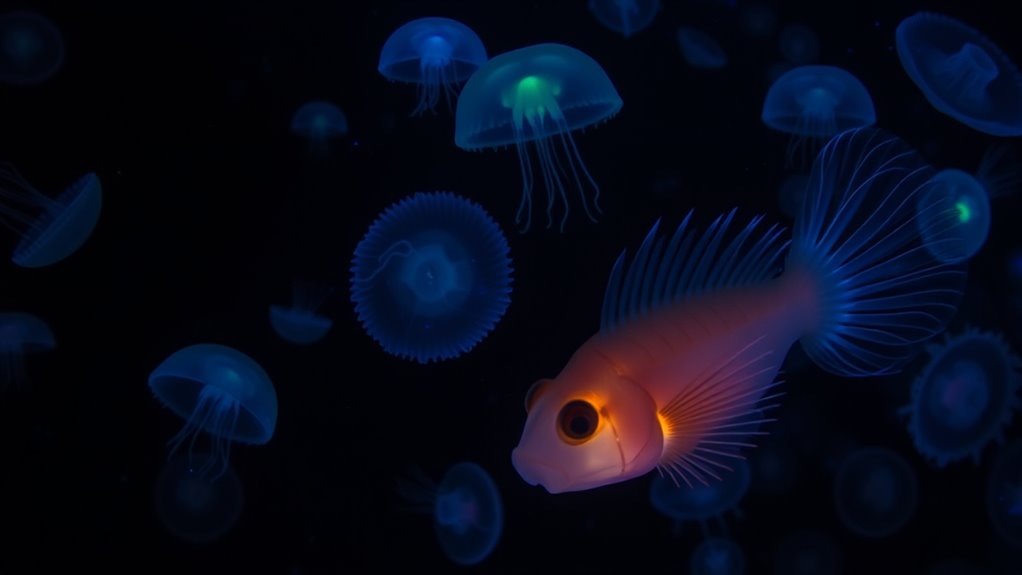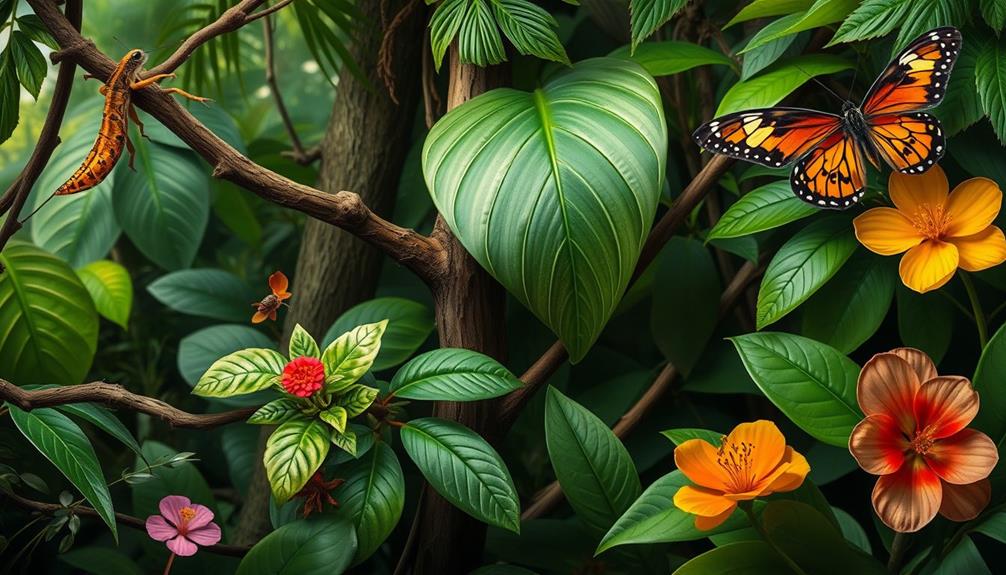Animals that glow in the dark, like deep-sea fish, fireflies, and bioluminescent fungi, do so through special chemical reactions involving enzymes like luciferase and substrates like luciferin. This ability helps them attract prey, communicate, or defend themselves in dark environments. Their bioluminescent pathways are fascinating examples of evolution’s adaptations for survival in extreme habitats. If you want to discover how these incredible creatures produce light, keep exploring this enthralling science.
Key Takeaways
- Many animals produce light through chemical reactions involving enzymes like luciferase and substrates like luciferin.
- Deep-sea creatures such as anglerfish and jellyfish use bioluminescence to attract prey or mates.
- Fireflies use flashing light patterns for communication and attracting mates.
- Some fungi emit glow-in-the-dark light to deter predators or attract insects.
- Bioluminescent defense mechanisms include startling predators with sudden flashes or creating confusing glowing clouds.

Many animals have evolved the ability to glow in the dark, creating mesmerizing displays that serve various survival purposes. This natural phenomenon, known as bioluminescence, occurs when specialized chemical reactions produce light within an organism’s body. At the core of this process are bioluminescent pathways—complex systems involving enzymes like luciferase and substrates like luciferin. These pathways enable animals to produce light efficiently, often in vibrant colors, without the need for external light sources. Understanding these pathways reveals the fascinating ways evolution has shaped survival strategies across different species.
Bioluminescent pathways enable animals to produce vibrant light for survival in darkness.
The evolutionary advantages of bioluminescence are numerous and compelling. You might notice that many glowing animals use their light to attract prey or mates, making hunting and reproduction more successful in the dark depths of the ocean or dense forests where visibility is limited. For example, some deep-sea fish display glowing patterns that lure smaller creatures toward their mouths, increasing their chances of feeding. Similarly, fireflies use their bioluminescent signals to find mates, with specific flash patterns acting as visual cues that help ensure reproductive success. These displays give animals a competitive edge, allowing them to thrive in environments where other sensory cues are less effective.
Another significant advantage is the use of bioluminescence as a defense mechanism. When threatened, many animals can produce sudden flashes of light to startle predators or create a distraction, giving them time to escape. For instance, certain jellyfish and squid release bioluminescent clouds, confusing attackers and reducing the likelihood of being caught. Some species even use their glow as a form of camouflage, blending into the faint light filtering from above or the dark surroundings to avoid detection. This counterillumination helps them remain hidden from predators, increasing their survival chances.
Furthermore, bioluminescence facilitates communication between individuals. You may find that creatures like bioluminescent fungi or deep-sea fish use their glow to coordinate with others in their community, whether for social bonding or alerting about danger. These luminous signals can transcend language barriers, making them effective tools in the dark or murky environments they inhabit. Over millions of years, natural selection has refined these bioluminescent pathways, ensuring that animals derive maximum benefit from their ability to glow.
In essence, the development of bioluminescence exemplifies how evolution equips animals with unique tools for survival. The intricate bioluminescent pathways are not just beautiful; they are essential adaptations that enhance hunting, protection, and communication in some of the planet’s most challenging habitats. By harnessing the power of light, these creatures demonstrate nature’s ingenuity in turning darkness into an advantage, giving you a glimpse into the extraordinary ways life persists and thrives in the shadows.
Frequently Asked Questions
Do All Bioluminescent Animals Produce the Same Light Color?
Not all bioluminescent animals produce the same light color. You’ll notice variations due to different bioluminescent pigments, which influence the light color variation. Some emit blue or green light, ideal for deep-sea environments, while others produce yellow, red, or orange hues. These pigments determine the specific color, helping animals attract prey, communicate, or camouflaging in their habitats. So, the light color isn’t universal but adapted for each species’ needs.
How Do Bioluminescent Animals Communicate With Each Other?
Think of bioluminescent animals as underwater flashlights, flickering messages through the dark. You see, they use bioluminescent signaling as a form of visual communication, turning their glow into Morse code. This glow sparks signals for attracting mates, warning predators, or marking territory. By flashing patterns or steady glows, they turn their luminous bodies into communication tools, creating a silent yet vibrant language that only fellow creatures understand in the depths.
Can Humans Harness Bioluminescence for Practical Uses?
You might wonder if humans can harness bioluminescence for practical uses. The answer is yes; scientists explore bioluminescent medical applications, like tracking disease progression or delivering targeted therapies. Additionally, bioluminescence in renewable energy shows promise for organic light sources. While still developing, these innovations could revolutionize medicine and sustainable energy, making bioluminescence a fascinating tool for future technologies.
Are Bioluminescent Animals More Common in Specific Environments?
You might notice bioluminescent animals are more common in specific environments like marine caves and deep-sea habitats. These dark, remote areas favor creatures that produce their own light, helping them hunt or communicate. In such environments, bioluminescence becomes a survival tool, making it more prevalent. So, if you’re exploring deep oceans or caves, you’re more likely to encounter animals that glow in the dark due to their unique adaptations.
How Do Bioluminescent Organisms Avoid Predators?
You wonder how bioluminescent organisms avoid predators. They use clever camouflage strategies, like glowing to blend in with their surroundings or to mimic harmless objects. Additionally, their predator deterrence techniques include flashing light to startle predators or creating sudden illumination to escape quickly. These tactics help them stay safe while using their glow as a tool for survival, making them fascinating examples of nature’s ingenuity.
Conclusion
Just like Pandora’s box revealed wonders beyond imagination, the world of bioluminescent animals unbars nature’s secret magic. Their glowing displays remind you that even in darkness, life finds a way to shine. As you now see these creatures’ brilliance, remember that nature’s mysteries are waiting to be uncovered, inspiring awe and curiosity. Keep exploring, because who knows what other luminous secrets lie hidden in the depths of our planet’s dark corners.










